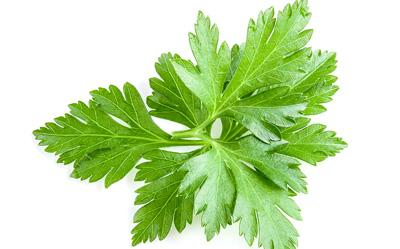

Petroselinum crispum (Mill.) Fuss
|
Parsley is a leafy vegetable belonging to the family Apiaceae. Parsley is a rich source of essential, flavonoids apigenin and carotenoids. Parsley is used as spice and flavouring additive in foods. Parsley has strong antioxidant activity and its increases superoxide dismutase and glutathione reductase levels. They prevent platelet aggregation and have immunomodulatory properties by suppressing nitric oxide production and lymphocytes proliferation. Mode of Consumption : Fresh, in seasoning, garnishing |
| Plant Details | Agro-climatic Zone | Vernacular Names | Pictures |
| Scientific Name: Petroselinum crispum (Mill.) Fuss Family: Apiaceae Lindl. Class: Magnoliopsida Order: Apiales Genus: Petroselinum Hill Fruiting Season: All round the year Parts: Leaf |
|
Andhra Pradesh : Parsli Assam : Joni xaak Bihar : Ajmod Himachal Pradesh : Ajmod Karnataka : Parsli Kerala : Aaranava Tamil Nadu : Vokkocu Uttar Pradesh : Ajmod |
 Leaf |
| Compound/Extract | Activity | Mode of Action | Marker/References |
| Raw leaves | Antioxidant | Increased levels of Erythrocyte glutathione reductase (GR) and superoxide dismutase (SOD) compared with those in the basic diet received group. | Erythrocyte glutathione reductase (GR) and SOD[3] |
| Genins extracted from leaves | Anti-platelet aggregation | Decreased adhesion of human platelets to collagen surface and also inhibited platelet aggregation in all models dose dependently due to factors like collagen, ADP, thrombin,arachidonic acid, epinephrine. | Human platelets[4] |
| Oil from leaf powder | Immunomodulatory | NO production and T cell proflifiration was reduced significantly. | NO and T cell [5] |
| Major Class | Metabolites (Content of bioactives: mg/100g Fresh Weight) |
| Carotenoid | Lutein/zeaxanthin: 5.6, β-carotene : 5.05[1] |
| Flavonoid | Apigenin : 510-630, Luteolin : 0-4[2] |
| Effect | Observation | DOI |
| Animal model studies | Increase in Lactobacilli spp. and SCFAs | DOI: 10.3390/nu14214650 |
| Disease | Formulation | Reference | Author | TKDL |
| Paralysis/Hemiplegia(Faalij),Bell's palsy(Laqwa),Cramp/Convulsion/Spasm(Tashannuj),Flaccidity (Istirkha),Diseases of head and neck(Amraaz-e-raas wa unuq),Headache (Suda'),Headache (Migraine)(Suda'-e-Nisfi/Shaqeeqa),Giddiness(Duwaar),Psychosis/Insanity/Mania(Mania/Junoon),Epilepsy(Sara/Mirgi),Congenital deafness(Samam/Samma),Apoplexy(Sakta),Otalgia(Waja-ul-Uzn),Pain(Waja),Dyspnoea(Usr-e-Tanaffus),Quartan Fever(Humma-e-Riba'),Paroxysmal fever/intermittent fever(Humma-e-Naaeba/Humma-e-Daaerah),Arthralgia(Waja'-al-Mafaasil),Sciatica (Irqun Nasaa),Gout (Niqris),Alopecia Furfuracea(Daa-al-Hayyah),Alopecia (Daa-al-Sa'lab),Leucoderma/Vitiligo(Baras),Ptyriasis Alba(Bahaq-e-Abyaz),Scrofula / Cervical lymphadenitis (Khanaazeer/Kanth Maala) | Ayarij Jalinoos Ba Nuskha-e- Ibn-e- Saraafiyun | Al-Qaanoon-fil-Tibb, Vol. V | Abu Ali Ibn-e-Sina, Institute of History of Medicine and Medical Research, Jamia Hamdard, New Delhi-62, 1987 | Unani |
| Ascites(Istisqaa -e- Ziqqi),Biliary Colic(Qoolanj-e-safrawi),Spleenalgia(Waja'-ul-Tehaal),Jaundice(Yaraqaan-e-Asfar),Chronic Abscess(Dubaila),Hepatalgia(Waja-ul-Kabid) | Kalkalaanaj Sagheer | Al-Qaanoon-fil-Tibb, Vol. V | Abu Ali Ibn-e-Sina, Institute of History of Medicine and Medical Research, Jamia Hamdard, New Delhi-62, 1989 | Unani |
| Hallucinations(Wasawis),Fear(Khauf),Palpitation(Khafaqaan),weakness of heart(Zo'f-e-qalb),Neurological diseases(Amraaz-e-raas),Colic (Qoolanj),Arthralgia(Waja'-al-Mafaasil),Chronic fever(Humma-e-Muzmina) | Maajoon-e- Yaaqoot Lana | Al-Qaanoon-fil-Tibb, Vol. V | Abu Ali Ibn-e-Sina, Institute of History of Medicine and Medical Research, Jamia Hamdard, New Delhi-62, 1988 | Unani |
| Gastralgia(Waja'-ul-Meda),Hepatalgia(Waja-ul-Kabid),Chill and rigors(Larzah-wa-Qasha'reerah),Fever/Pyrexia(Humma) | Majoon-e- Foodanaj | Al-Qaanoon-fil-Tibb, Vol. V | Abu Ali Ibn-e-Sina, Institute of History of Medicine and Medical Research, Jamia Hamdard, New Delhi-62, 1987 | Unani |
| Information from Wealth of India | Reference |
|
CSIR(1966).The Wealth of India, Raw materials,Vol.-VII,P.328-330, New Delhi, India |
| 4.2, 04.2.1, 04.2.1.1, 04.2.1.3, 04.2.2.3, 04.2.2.5, 04.2.2.6, 04.2.2.8 |
| CSIR-North East Institute of Science and Technology, Jorhat-6, Assam, India
CSIR-Institute of Himalayan Bioresource Technology, Palampur-61,Himachal Pradesh, India |